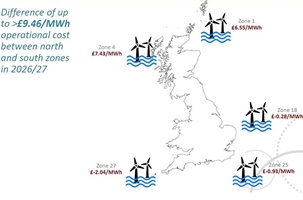 A new report has laid bare the impacts of the higher transmission charges faced by Scottish offshore wind generators compared to projects in the south of Great Britain.
A new report has laid bare the impacts of the higher transmission charges faced by Scottish offshore wind generators compared to projects in the south of Great Britain.The research, commissioned by the Scottish Offshore Wind Energy Council (SOWEC), was carried out by ITPEnergised, and uses the latest National Grid ESO forecasts for Transmission Network Use of System charges.
While charges are already highest in northern Scotland and lowest in SW England, the report finds that charges in some zones are expected to double, compounding the challenge for Scottish projects to lower the cost of energy, compete for government subsidies and attract continued investment into the sector. The report shows that:
- The difference in charges between the highest and lowest tariff zones is also projected to double from 2016/17 to 2026/27, increasing from £23 to £48 for every kW of capacity connected to the transmission network.
This will see annual charges for a notional 1GW project range from in excess of £33m in the northwest of Scotland to a ‘negative charge’ of -£9m in southwest England in 2026/27.
When translated into the impact on the cost of each energy produced, presuming a constant load factor of 51 per cent:
- The impact of charges on the cost of energy would range from £7.43/MWh to -£2.04/MWh, a difference of £9.47/MWh.
- The maximum difference between potential ScotWind and Crown Estate Leasing Round 4 projects is £8.36/MWh (Zone 4 = £7.43; Zone 25 = -£0.93).
- Transmission Network Use of System (TNUoS) would cost Scottish projects eligible to bid in CfD Allocation Round 4 between £0.96 and £8.09 per MWh more than projects off the east coast of England. The biggest cost differences would occur for projects connecting in the north of Scotland (transmission zone 1 which is the zone closest to the majority of ScotWind leasing zones).
For comparison, successful offshore wind projects in the 2019 CfD Allocation Round secured strike prices of between £39.65 and £41.61 per MWh, meaning that transmission charges represent up to 20 per cent of project bids in the worst-affected parts of Scotland.










